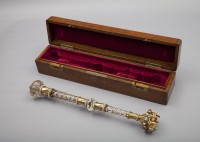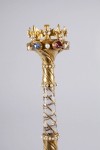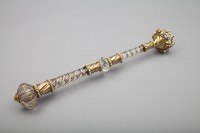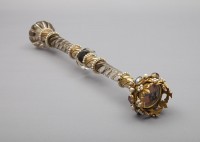 For the first time in 600 years, a sceptre King Henry V gave to the City of London in gratitude for its support in the Hundred Years’ War will go on public display. The City of London helped finance the Battle of Agincourt, loaning Henry 10,000 marks (about three million pounds in today’s money). After Henry’s forces won so decisive a victory against the flower of French chivalry arrayed in much greater numbers against them on October 25th, 1415, the king had the sceptre made and presented it to the city as a thank you gift.
For the first time in 600 years, a sceptre King Henry V gave to the City of London in gratitude for its support in the Hundred Years’ War will go on public display. The City of London helped finance the Battle of Agincourt, loaning Henry 10,000 marks (about three million pounds in today’s money). After Henry’s forces won so decisive a victory against the flower of French chivalry arrayed in much greater numbers against them on October 25th, 1415, the king had the sceptre made and presented it to the city as a thank you gift.
Made by the finest craftsmen — including French ones — of the age, the sceptre is 17 inches long and made out of two spiral-carved stems of rock crystal with ribbons of inlaid gold. At the top of the sceptre is a gold crown topped with fleurs-de-lis and crosses and decorated with gemstones from around the world: red spinels from Afghanistan, sapphires from Ceylon, pearls from the Arabian gulf. Inside the crown is the king’s coat of arms painted on parchment. The sceptre was made between 1415 and February of 1421 when it appears in a painting of the coronation of Catherine of Valois, wife of Henry V.
 It’s a near-miracle that the sceptre has survived all this time.
It’s a near-miracle that the sceptre has survived all this time.
Under the republican protectorate of Oliver Cromwell which followed the Civil War, the Crown Jewels were sold off and there was a danger the sceptre could have met the same fate, had it not been hidden away by the City authorities.
Eight years after Cromwell’s death and the restoration of the Monarchy which followed, it took the cowardly self-interest of the serving Lord Mayor to save the sceptre.
During the Great Fire of London of 1666, Sir Thomas Bloodworth – rather than lead the rescue efforts – made sure his personal treasures were safely sent out of the City, including the sceptre, only returning in person three days later.
It’s been seen by very few people in the past 600 years. The sceptre emerges from the protective confines of London’s Guildhall during Coronations when it is borne by the Lord Mayor of London, and for the “Silent Ceremony” in which the outgoing and incoming Lord Mayor place their hands upon it during the annual inauguration of a new mayor. The last time it was seen in public was at the 1953 Coronation of Queen Elizabeth II.
 The sceptre’s connection to Agincourt was only recently discovered by Dr. Michael Hall, curator of the Rothschild Collection at Exbury House, Hampshire, and Ralph Holt while researching the treasures of Mansion House, the official residence of the Lord Mayor of London since the 18th century. Dr. Hall and Mr. Holt with the help of Dr. Clare Taylor, wife of former Lord Mayor Sir Roger Gifford, have authored a book on the silver and gold of Mansion House. The book, the third in a series about the collections of Mansion House, covers more than 80 precious objects, including the regalia of the Mayorality.
The sceptre’s connection to Agincourt was only recently discovered by Dr. Michael Hall, curator of the Rothschild Collection at Exbury House, Hampshire, and Ralph Holt while researching the treasures of Mansion House, the official residence of the Lord Mayor of London since the 18th century. Dr. Hall and Mr. Holt with the help of Dr. Clare Taylor, wife of former Lord Mayor Sir Roger Gifford, have authored a book on the silver and gold of Mansion House. The book, the third in a series about the collections of Mansion House, covers more than 80 precious objects, including the regalia of the Mayorality.
 The Honour and Grandeur: Regalia, Gold and Silver at the Mansion House will be released later this month to coincide with the 600th anniversary of the Battle of Agincourt. This is the first time the sceptre has been published in its long life, believe it or not. The sceptre itself will celebrate the anniversary by going on public display for the first time. Unveiling the Crystal Sceptre: Henry V’s Gift to the City opens at Guildhall Art Gallery on Saturday, October 24th, the day before St. Crispin’s Day. The exhibition will tell the full story of the sceptre, starting with the City of London’s financial support for Henry V’s great battle and following King Henry’s 1421 pilgrimage to holy sites associated with his three patron saints.
The Honour and Grandeur: Regalia, Gold and Silver at the Mansion House will be released later this month to coincide with the 600th anniversary of the Battle of Agincourt. This is the first time the sceptre has been published in its long life, believe it or not. The sceptre itself will celebrate the anniversary by going on public display for the first time. Unveiling the Crystal Sceptre: Henry V’s Gift to the City opens at Guildhall Art Gallery on Saturday, October 24th, the day before St. Crispin’s Day. The exhibition will tell the full story of the sceptre, starting with the City of London’s financial support for Henry V’s great battle and following King Henry’s 1421 pilgrimage to holy sites associated with his three patron saints.
During that pilgrimage he may have stopped in Hedon where he presented the mayor with another Agincourt-related treasure: the Hedon Mace, an iron mace believed to have been an actual weapon used at the Battle of Agincourt which Henry had silver-gilt and presented to the city again as thanks for its support. The Hedon Mace will be on display with the Crystal Sceptre, the only objects given by Henry V that have remained with their original recipients for 600 years.